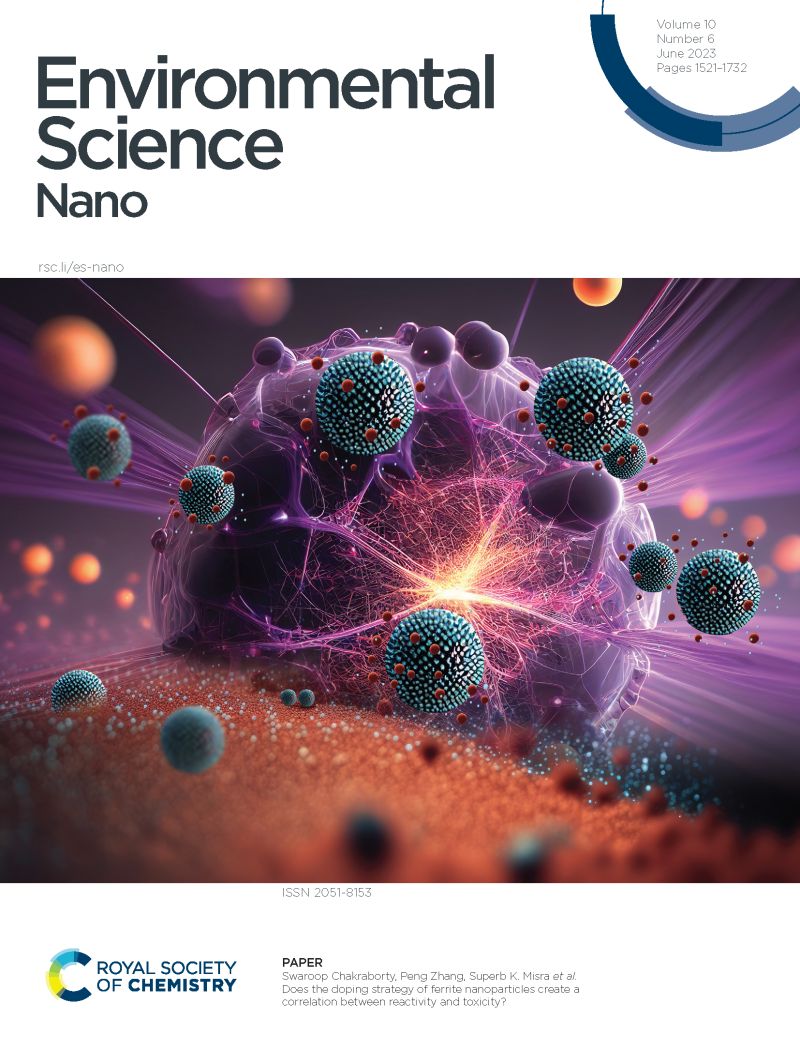褪黑激素功能化氧化锌纳米粒子通过调节抗氧化剂和离子稳态来增强芒果的耐盐性
IF 5.1
2区 环境科学与生态学
Q1 CHEMISTRY, MULTIDISCIPLINARY
引用次数: 0
摘要
盐度是一种重要的非生物胁迫,通过诱导渗透胁迫、扰乱离子稳态、促进氧化损伤等方式,显著限制植物的发育和生产。本研究探讨了盐胁迫对黑克豆(Vigna mungo L.)的影响,以及氧化锌NPs (ZnO NPs)和褪黑素功能化氧化锌NPs (MZ NPs)引发种子缓解盐胁迫的能力。据我们所知,这是第一次研究MZ NPs在盐度胁迫下对植物的影响。盐胁迫显著降低了生长指标、叶绿素、类胡萝卜素和钾含量,增加了氧化应激、渗透保护剂、钠离子和钙离子水平。在各处理中,MZ NPs对生长指标的促进作用最为显著,其次是单独施用ZnO NPs和褪黑素(MT)。氧化锌NPs和MZ NPs通过稳定光合色素、降低离子浓度、促进钾吸收、提高抗氧化酶活性、调节离子转运和抑制钠毒性等途径增强了盐胁迫对植物的抗性。有趣的是,MZ NPs在恢复光合色素、降低氧化应激、优化抗氧化酶活性和降低钠浓度方面具有更强的能力。此外,它们完全恢复了钾的含量,减少了渗透保护剂的过度积累,表明它们以平衡的方式应对压力。研究结果表明,ZnO NPs与褪黑素结合具有互补优势,为提高植物耐盐性和促进作物可持续种植提供了一种有希望的策略。本文章由计算机程序翻译,如有差异,请以英文原文为准。
Melatonin-functionalized zinc oxide nanoparticles enhance salt stress tolerance in Vigna mungo L. by regulating antioxidants and ion homeostasis
Salinity is a significant abiotic stress that significantly restricts plant development and production by inducing osmotic stress, disturbing ion homeostasis, and promoting oxidative injury. This research explored the impact of salt stress on Vigna mungo L. (black gram) and the ability of seed priming with zinc oxide NPs (ZnO NPs) and melatonin-functionalized ZnO NPs (MZ NPs) in conferring salinity stress mitigation. This is, to the best of our knowledge, the first work in examining MZ NPs' impact on plants under salinity stress. The salt stress significantly reduced growth indices, chlorophyll, carotenoids, and potassium contents and increased oxidative stress, osmoprotectants, sodium ion, and calcium ion levels. Among the tested treatments, MZ NPs provided the most significant enhancement in growth indices, followed by ZnO NPs and melatonin (MT) application in individual form. Seed priming with ZnO NPs and MZ NPs fortified plants against salt stress by stabilizing photosynthetic pigments, decreasing ion concentration, enhancing uptake of potassium, increasing activities of antioxidant enzymes, regulating ion transport, and suppressing sodium toxicity. Interestingly, MZ NPs possessed greater ability in restoring photosynthetic pigments, diminishing oxidative stress, optimizing activities of antioxidant enzymes, and downplaying sodium concentration. In addition, they completely recovered the contents of potassium and reduced excessive accumulation of osmoprotectants, revealing that they were coping well with stress in a balanced fashion. The findings demonstrate the complementary advantage in combining ZnO NPs with melatonin, presenting a promising strategy in enhancing salt stress tolerance in plants and encouraging the cultivation of crops in a sustainable way.
求助全文
通过发布文献求助,成功后即可免费获取论文全文。
去求助
来源期刊

Environmental Science: Nano
CHEMISTRY, MULTIDISCIPLINARY-ENVIRONMENTAL SCIENCES
CiteScore
12.20
自引率
5.50%
发文量
290
审稿时长
2.1 months
期刊介绍:
Environmental Science: Nano serves as a comprehensive and high-impact peer-reviewed source of information on the design and demonstration of engineered nanomaterials for environment-based applications. It also covers the interactions between engineered, natural, and incidental nanomaterials with biological and environmental systems. This scope includes, but is not limited to, the following topic areas:
Novel nanomaterial-based applications for water, air, soil, food, and energy sustainability
Nanomaterial interactions with biological systems and nanotoxicology
Environmental fate, reactivity, and transformations of nanoscale materials
Nanoscale processes in the environment
Sustainable nanotechnology including rational nanomaterial design, life cycle assessment, risk/benefit analysis
 求助内容:
求助内容: 应助结果提醒方式:
应助结果提醒方式:


